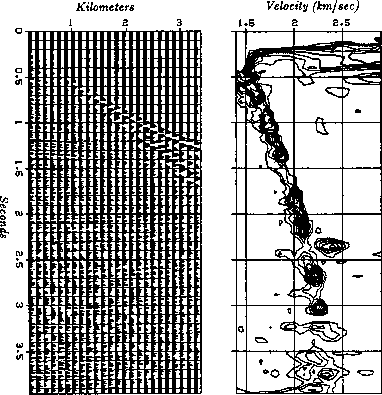 |
Figure 2 NMO at constant velocity with velocity analysis. (Hale)
A conventional velocity analysis uses a collection of trial velocities. Each trial velocity is taken to be a constant function of depth and is used to moveout correct the data. Figure 2 (left) exhibits the CMP gather of Figure 1 (left) after moveout correction by a constant velocity. Notice that the events in the middle of the gather are nearly flattened, whereas the early events are undercorrected and later events are overcorrected. This is typical because the amount of moveout correction varies inversely with velocity (by Pythagoras), and the earth's velocity normally increases with depth. A measure of the goodness of fit of the NMO velocity to the earth velocity is found by summing the CDP gather over offset. Presumably, the better the velocities match, the better (bigger) will be the sum. The process is repeated for many velocities. The amplitude of the sum, contoured as a function of time and velocity, is shown in Figure 2 (right).
 |
In practice additional steps may be taken before summing. The traces may be balanced (scaled to be equal) in their powers and in their spectra. Likewise the amplitude of the sum may be normalized and smoothed. (See Taner and Koehler [1969]). Also the data may be edited and weighted as explained in the next subsection.
The velocity giving the best stack is an average of the earth's velocity above the reflector. The precise definition of this average is deferred till later.